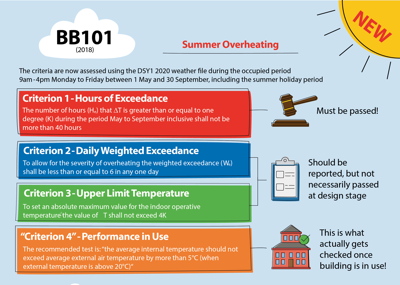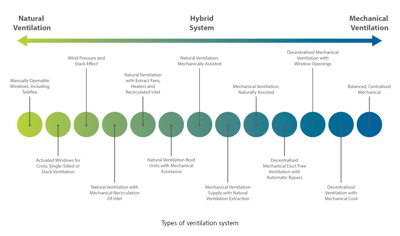Must do better
BB101 Guidelines on ventilation, thermal comfort and indoor air quality in schools was updated in August 2018, and it sets some tough targets for building services. The document addresses three key services-related areas in school buildings: ventilation; thermal comfort; and indoor air quality (IAQ) – and introduces higher standards for all of them.
 |
|
New summer heating criteria (courtesy of Breathing Buildings) |
With the August 2018 update, which replaces BB101 2016, government has now aligned BB101 with the latest health and safety standards, and also aims to improve thermal comfort and IAQ with a view to creating ‘healthier outcomes for students’.
Designers, contractors and installers will see that BB101 has toughened its approach to several areas. There are more stringent air quality targets; tougher rules on summertime overheating; and a strong focus on avoidance of draughts. The elements of IAQ, thermal comfort and energy efficiency must be carefully balanced under the new rules.
Tougher targets
The industry has largely welcomed this tougher approach. David Bradbury of SAV says: “The key changes in BB101 2018 will have a very positive impact on creating a healthy and comfortable learning environment. For example, there is now clearer guidance on controlling draughts. To tackle the issue of poor outdoor air quality, better air filtration is now recognised as a necessary solution. At the same time, IAQ and noise levels need to be kept under control.”
And Matthew Bray, commercial director at Breathing Buildings, comments: “We welcome the updated BB101 since it comprehensively addresses the issues of air quality, thermal comfort and energy use, all of which are key to the design of ventilation systems in schools. This guidance will help ensure that we have efficient, healthy and comfortable environments in schools so children will benefit from effective teaching and learning spaces.”
The government’s approach sets the bar high for performance of ventilation systems. Classroom guidelines include maximum CO2 limits which cannot be breached for 20 consecutive minutes. BB101 2018 also introduces hybrid ventilation systems along with the traditional natural and mechanical ventilation approaches – which gives designers another option to consider.
Gary Morgan, director at Eco-Airvent, points out that the update clarifies some important issues and requirements: “Ventilation is now clearly defined as Natural - NO FAN or Mechanical WITH FAN.”
He also highlights the new standards for ventilation levels, depending on the type of system in use. “If you are using natural ventilation the average CO2 level must be less than 1500ppm. This equates to 5 l/s per person. If you are using hybrid, mixed mode or mechanical ventilation, the CO2 level limit is less than 1000ppm. This equates to 8 l/s per person. Previously, many hybrid systems supplied only 160l/s of fresh air in winter conditions. Now, 256 l/s of fresh air is required to satisfy CO2 level when fan is running.”
 |
|
Types of ventilation system (courtesy of SAV) |
Fresh not draughty
Bradbury adds that the measurement of average CO2 levels is important: “The goal posts for average IAQ are given in terms of average CO2 values in classrooms during the occupied period, defined as 9am to 4pm. This means that periods of low occupancy such as breaks and lunch periods, can be taken into account, as well as periods of full occupancy.”
BB101 also focuses on reducing draughts in classrooms. Breathing Buildings was part of the advisory board for BB101 and designed two of the supporting design calculation tools, including the cold draught calculator. Matthew Bray says: “This is important since draughts can either raise heating bills by increased use of radiators or affect air quality with teachers closing windows to reduce draughts. Therefore, in winter the new guidance advises the mixing of incoming cold air with warm room air to avoid cold draughts in the occupied zone.”
Cutting overheating
Overheating is also in the sights of BB101. Full occupancy is now to be assumed throughout the holiday period. And the rules state that there should be no more than 40 hours between 1st May to 30th September when the temperature is 1oC above the allowable maximum.
Calculations in BB101 use variable maximum indoor temperatures that depend on the outside temperature. The BB101 document states: “This helps avoid the unnecessary use of air conditioning by using passive measures such as night cooling and thermal mass to cool spaces in summertime.”
Indoor air quality is of course on the political agenda at the moment, particularly in cities such as London, where pollution levels are rising steadily. BB101 brings requirements for IAQ in line with the World Health Organisation (WHO) performance levels.
This has implications for filtration, says Bradbury: “To minimise the effect of polluted air, recommended filter grades are now derived from standards set by the World Health Organisation (WHO-2005). For polluted areas, filters to at least ePM1 55% are required. This means that for more or less any schools within the London area and other city centres, mechanical ventilation with filtration will be the only acceptable solution.”
Gary Morgan concludes: “BB101 2018 contains 162 pages of regulations and guidance and gives a more detailed holistic approach to the internal environment in schools. It’s important that it is well understood by those actively working in the education design sector. BB101 works in tandem with BB93 acoustic design of schoolsperformance standards (2015), which outlines regulations relating to acoustic requirements. While not being too prescriptive, to allow designers to use innovative energy saving solutions, it does offer a better framework to steer sensible choices for building services equipment that should result in building better schools.”







